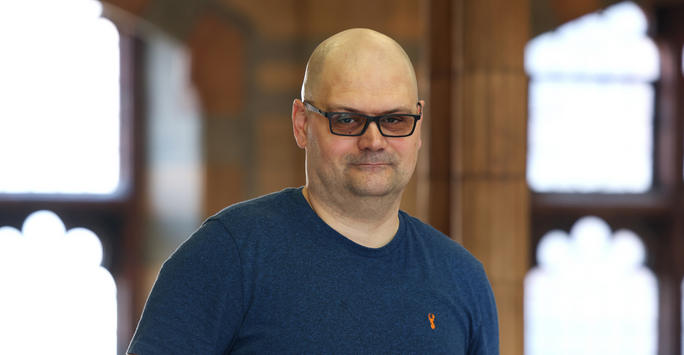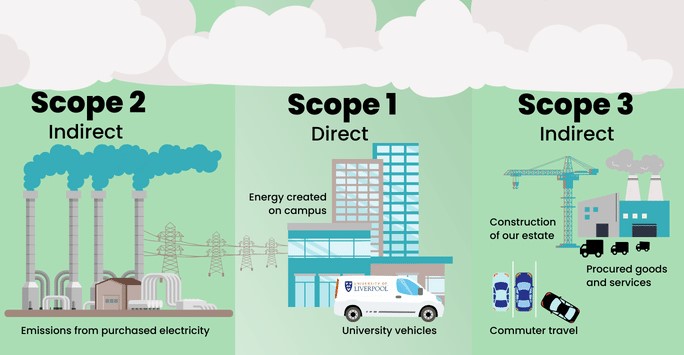
You’ll often see the terminology ‘Scopes 1, 2 and 3’ used when talking about carbon emissions, but what do these numbers mean? Karl Whittle, Professor of Zero Carbon and Nuclear Energy, explains.
Breaking down the scopes
“Scope 1 categorises the direct emissions the University creates on-campus,” says Karl. “This could be anything from the emissions generated as a result of teaching and research, the energy consumption of facilities and even the petrol and diesel used in University vehicles.”
Karl continues: “Scope 2 on the other hand is categorised as the indirect emissions that we have purchased from elsewhere. These emissions are generated off campus, such as the electricity, we receive via the National Grid. Scope 3, is a little harder to quantify, but it pretty much encompasses everything else. From the indirect emissions associated with the goods and services we purchase, the journey of our waste once it leaves campus, the carbon linked to our assets and built estate and even people’s commute to work, fall under Scope 3."

Examples of University Scope 1, 2 and 3 emissions
Measuring our emissions
The University’s Combined Heat and Power Energy Centre uses gas to generate over 65% of the electricity needed for the City Centre campus, contributing to our Scope 1 emissions. “Our campus’s energy is measured by hundreds of building meters controlled by FRCS across our estate,” says Karl. “For Scope 2, we are reliant on the emission figures provided by the external companies we purchase energy from on the Grid. As an institution, we aim to purchase energy from renewable energy sources, but any energy we purchase will have a carbon footprint associated to it. We then use this second-hand data to calculate our emissions.”
Karl continues: “It becomes more complex for Scope 3 emissions, because often they don’t always come with readily available data. If we take commuter travel for example, we can predict an individual’s carbon emission for a 12-mile drive to work, depending on details such as the model of car, but if that individual occasionally walks to work, or carpools on various days, their emissions diminish, making it much more difficult to track their carbon output.”
Reducing our emissions
The University has already invested in a range of measures to reduce its emissions. By using gas to generate electricity, the Combined Heat and Power Plant (CHP), has secured savings of 7,000 tonnes of CO2 each year, a 13% reduction in Scope 1 emissions for the University. Although a significantly more sustainable process than some other methods of generating electricity, the use of gas prevents the University from reaching its Net Zero target by 2035. This is why plans are currently being developed to find a way to fully decarbonise our campus.
“From a Scope 2 perspective, eventually and as per the government’s plans, all energy taken from the Grid will be sustainable by 2035. Currently, the required energy that we can’t produce ourselves due to demand is purchased from green sources, meaning we can report zero carbon emissions for our entire purchased electricity usage.”
Karl stresses that it’s not just big wins that are contributing to the University’s decrease in carbon emissions: “A little bit goes a long way when it comes to individual action,” he says. “Changes in behaviour, such as more sustainable commutes to work, avoiding single use plastics, are also effective in lowering the University’s emissions for Scope 3.”
Taking action
“There’s still a lot of work to be done to reach our goal of Net Zero Carbon by 2035,” says Karl. “Increasing energy efficiency in our estates is a primary example of how we can reduce our emissions. Currently, we heat and light our office and teaching spaces, even if they are not used to full capacity. Tackling this issue will take creative thinking about how and where we teach and work across the University to maximise space and reduce emissions.”
Karl adds: “Similarly, retrofitting – stripping and redesigning the internal structure - of these spaces to be more energy efficient, will significantly help to lower emissions.”
Measuring and quantifying Scope 3 emissions, is the most significant challenge we face. “How and what we purchase from external suppliers, has a huge impact on our carbon footprint,” continues Karl. “From the types of materials and processes used by contractors, to the carbon associated with large assets such as microscopes, Scope 3 emissions are often the largest contributors but are also the hardest to quantity, making it challenging to both measure and reduce them.”
On a positive note, each of us as individuals can help decrease our Scope 3 emissions. “Commuting to work is a prime example,” says Karl. “In order for widespread sustainable transformation to happen, large scale behavioural change need to happen, and this may require bold steps to be taken by the University to encourage these changes.”
“On the flip side, dogmatic beliefs can prevent us from being practical. If we are not careful, we can get bogged down in the details, preventing us from implementing crucial widespread changes,” he explains.
Karl continues: “We need to inspire colleagues to consider their own actions, while also ensuring that as an institution, we are actioning the big decisions that will have a dramatic effect on our carbon footprint as soon as possible".
Make a difference
For more information about energy linked carbon at the University, take a look at this dedicated webpage. For inspiration on how you can reduce your emissions, check out this information.